Blogpost by Founder Joe Grez
Few mariners have had the pleasure of inviting a horse aboard to row their dinghy. Many are familiar, though, with what a horsepower rating means on a boat, at least when powered by a gasoline engine. Unfortunately, the familiar hp rating system doesn't describe the comparative performance of electric to gas, or in many cases, electric to electric. Manufacturers have been scrambling for new ways to compare.
The most popular rating for electrics these days seems to be the "equivalent horsepower" rating. If rated this way, EP Carry would be 1.4 or 1.7 "equivalent horsepower" depending on the EP Carry firmware version installed. This rating, though, is only meaningful on the particular small boat used in testing. EP Carry also rates between 32 "lb thrust" and 105 "lb thrust" depending on the boat and test method. It has a propulsive efficiency of 60% on a small boat, or on a comparison basis, 2x Torqeedo's propulsive efficiency, which does not square with Torqeedo's efficiency claim of 48%. Clearly, these ratings are not self-consistent, so we do not post them (aside from here, for the purpose of making a point). The purpose of an outboard is to push your boat to a required speed for the required distance, not to produce a rating that doesn't work. That's why we provide an accurate online speed and range calculator.
I've written a big complicated article published in Professional Boatbuilder Magazine on rating of electric outboards by "lb thrust", "Input power", "horsepower", "equivalent horsepower" and "propulsive efficiency". Following is the condensed version.
"lb thrust":
We all understand the idea of force, so a "lb thrust" rating system seems like a natural way to describe a motor's output. But if a trolling motor produced its rated thrust, a 9ft rowboat would go somewhere around 5 knots with a cheap 30 "lb thrust" trolling motor, but it doesn't.
This 400 lb 9ft rowboat with a 30 "lb thrust" trolling motor can barely reach 3 knots at max power. At that speed, the boat's resistance is only 7 lbf. So what is going on here?
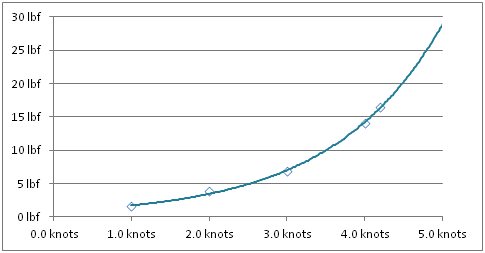
First off, let's look at rowing. It is possible to row this boat to 3 knots. To do so you would simply need to apply a time-average force of 7 lbf. Your pull stroke is actively pulling 1/2 of the time so the average force needed during the pull-stroke is higher by 2x; 2 x 7lbf = 14lbf. There are two oars so the average pull-stroke force per oar is 14lbf / 2 = 7lbf per oar. Let's assume that your 6ft oar protrudes 4.5ft outward, and the inboard portion is 1.5ft. In this case, your average in-stroke-force per oar would be 7lbf x 4.5/1.5 = 21lb. So with each hand, you're applying a 21 lbf average force during a stroke to produce a 7 lb average thrust. This high rowing effort is one reason we think a boat is harder to push than it is. And this mismatch is also supported by trolling motor manufacturers…
For any propulsion device, propulsive power = thrust force x speed. So at a fixed propulsive power, true thrust-force decreases as speed increases. The following graph shows what this means with an electric outboard at a constant throttle setting on a 9ft dinghy.
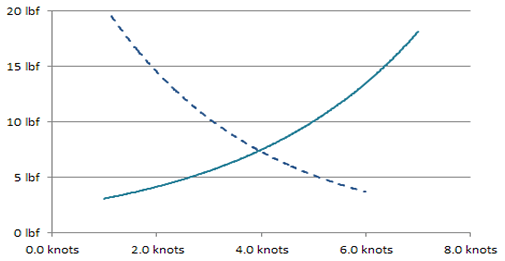
At low boat speeds, thrust exceeds hull-resistance so the dinghy accelerates. As the boat speeds up, acceleration decreases until thrust and resistance are in balance, at around 4 knots in this example. If you have a boat with lower resistance, the speed crossover point is higher in speed. If the boat is more heavily loaded, the crossover point is lower in speed.
You can see the problem with any thrust-based rating system; when thrust varies with speed, what thrust value should be used? I think that most people assume that the common rating must be based on a bollard pull test (boat speed is 0 knots), where the motor's maximum possible thrust can be measured independently on the boat's resistance curve. However, the Minn Kota Endura 30 we used for comparison testing has a 30 "lb thrust" rating yet it has a peak measured thrust of 18 lbf in a bollard pull test while drawing nearly 300W of input power. So any trolling motor's maximum thrust happens only when pulling against secure moorings and that value is only around 60% of the rated thrust value. Clearly, trolling motors are not rated in any kind of force test measurement system involving water and a propeller. Instead, trolling motors are rated using a calculation that relates "lb thrust" to their max rated input electrical power. In other words, water and boats have nothing to do with this rating system.
Because EP Carry provides higher speeds at lower input power levels, there really is no honest way to quantify our performance with a single "lb thrust" rating. If we use a trolling motor's input power multiplier, we would produce a very low "lb thrust" value based on our low input power requirements. If we use a bollard pull rating, we'd need to multiply by 1.7 for an equivalent rating but that is irrelevant unless comparing zero boat-speed pulling force. And in that case why use the 1.7x multiplier? Finally, if we base a "lb thrust" rating on actual thrust at a particular speed, what speed or boat should we choose? Based on our measurements, all the following statements are true at the same time:
You can see why EP Carry doesn't want to enter the "lb thrust" rating game. But we're not done yet. Sea-trial data comparing a 30 "lb thrust" Minn Kota vs. an EP Carry on a 9 ft dinghy is shown below.
EP Carry vs a 30 lb thrust trolling motor on a 9ft rowboat.
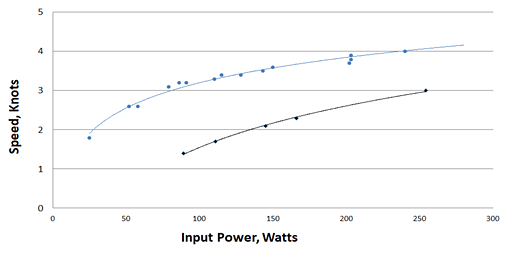
This trolling motor requires 3.2x – 4.5x more input power vs. EP Carry to produce the same speeds. So for a reasonable range at normal speeds, a trolling motor needs a 3.2x – 4.5x larger battery that's heavier, more expensive and requires 3.2x to 4.5x more juice to recharge.
Though trolling motors can push a boat, the "lb thrust" rating system helps manufacturers hide their relatively poor speed and range performance. Unfortunately, this problem extends to other rating systems as well…
Horsepower:
The standardized horsepower rating is actually a direct measurement (yay). It is the maximum possible mechanical shaft power (proportional to RPM x torque) produced by a gas outboard operating at its peak power RPM. This measurement can be done for an electric motor too. The standard Mercury Avator 7.5e is rated at 3.5 "equivalent horsepower". But their website also says it produces 750W, or 1 hp of peak shaft horsepower. If we make a custom Mercury Avator with a peak shaft horsepower measurement of 3x that rating (3 hp), it would be equivalent to a 3 hp gas outboard for high-speed legs of a race where conditions, boats, motors, and props are highly optimized to allow each motor to reach their full rated RPM/max-power point. But on a dinghy this electric would perform like an 8-9 hp gas motor. So for highly optimized racing applications you would well-served by using today's gas hp rating standard. But for most applications you'd be quite overpowered. Because of battery costs, you'd spend way too much, and because of battery weight, it would be quite heavy. To fully understand this requires some explanation involving two factors: torque-fade, and propeller design…
Torque-fade:
As we said, a gas motor loses torque when loaded down. But an electric motor maintains or even increases torque under high load conditions (that's why a Tesla, Chevy Bolt, or Rivian need no torque converter or clutch when accelerating from a stop). In the following chart, we created some torque curves for hypothetical gas vs electric outboards (dotted lines) at their full-throttle settings. Using the power = torque x RPM relationship, we then calculated the power output of these two motors at various RPMs. In this example, the peak hp for the gas powered motor is 3 hp and the peak for the electric is 1.8hp. But within the typical-use zone (the green area), the electric is more powerful under high loads (lowered RPM) and the gas motor is better with light loads. This is purely because of the different torque characteristics of the two motors.
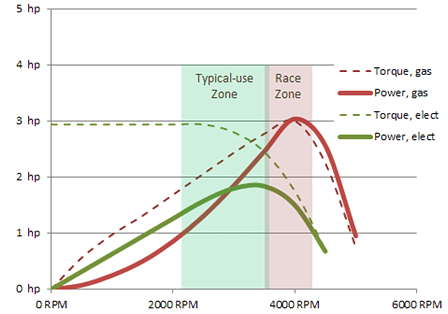
Torque curve differences are part of the reason an electric motor provides competitive propulsive value at a much lower peak hp rating. For outboards, differences in propeller design are also relevant.
Propeller:
So, between torque-fade and propeller differences, electric outboard manufacturers cannot use the peak shaft horsepower rating system to provide a meaningful comparison to their customers. So instead, electric manufacturers use an "equivalent" value.
Equivalent horsepower:
Combining the effects of torque and propeller has resulted in the electric outboard industry formulating an input-power multiplier to calculate an "equivalent horsepower" rating. This input power multiplier varies depending on the particular efficiency of the product; the higher multiplier, the higher the motor's relative efficiency. But all pod motors use a multiplier that is similar.
For example, the Torqeedo® 1003 we tested has a max input power of 1,000W. When this power is expressed as horsepower (745.7W = 1 hp), the max input power is 1.3hp. Multiplying 1.3hp by the factor 2.2x produces 3 "equivalent horsepower", and this equals the 1003C's advertised rating.
ePropulsion's spirit 1.0 claims a 1,000W input power and a 3 hpe rating. Using Torqeedo's multiplier, ePropulsion produces the 3 "equivalent horsepower" rating they also claim.
The Mercury Avator 7.5 is rated at 916W input and it is rated as a 3.5 "horsepower equivalent" outboard. Doing the same conversion from input power to hp requires a 2.8 multiplier to achieve their 3.5hpe rating. If all these motors are characterized properly, it appears that Mercury is around 14% more efficient than the other examples.
So let's look at what multiplier would be best for EP Carry. To do this we'll measure relative input powers vs speeds on a relevant boat.
Power vs speed data with EP Carry in blue and Torqeedo in orange
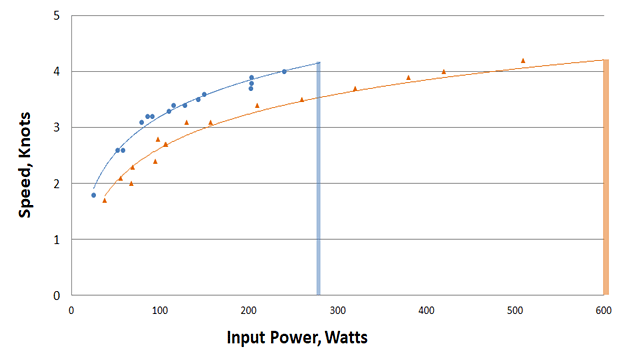
This graph illustrates how EP Carry requires ½ the power of a Torqeedo® 1003 to drive a 9ft dinghy to 4.2 knots. This dataset is the basis for our more general statement that EP Carry requires ½ the power of a Torqeedo to propel a small boat to the same speed.
Because of this 2x difference, EP Carry's multiplier would be 2 x 2.2x = 4.8x. and the resulting rating for EP Carry would be 1.7 "horsepower equivalent" for our higher power firmware (270W input) and 1.4 hp for our standard power firmware (220W input). But while this particular 4.8x solution would be a fair comparative assessment for the 9ft dinghy tested, there are all kinds of small boats where the multiplier could differ.
We feel that rating EP Carry this way, though comparable to how other electrics do it, is simply taking things too far. As a boater, you are interested in a lighter product with a smaller battery for a lower weight and cost, all while providing the same expected speeds and ranges. All these benefits are a direct result of efficiency.
Efficiency:
In theory, propulsive efficiency ratings would be a great way to compare motors if you know the input electrical power. But even propulsive efficiency ratings are problematic.
Using reasonably modern technologies, an electric propulsion system that is correctly optimized for a specific boat type produces 40% – 45% propulsive efficiency at cruise. An unusually well-optimized system is between 45% and 60%. When you see stated efficiency numbers higher than that (I've seen 98%), the advertiser is not quoting overall propulsive efficiency, but just the peak electric motor efficiency rating under optimal laboratory conditions. This leaves out the inefficiencies of shafts, gears, seals, lower unit resistance, propeller, and impedance matching which make up nearly all of the inefficiencies in the total system. Those I have tested, especially those with enclosed impellors or small caged props, produce propulsive efficiencies that are lower than a trolling motor.
Genuine propulsive efficiency ratings offered by manufacturers are peak values. The Torqeedo test graph shown above was done with a motor that Torqeedo claims operates at 48% propulsive efficiency. I am sure this is true on some kind of boat. But it's clear that their advertised propulsive efficiency is not realized on a 9ft dinghy, or our EP Carry's propulsive efficiency would be 96%. And I know it's not. Calculations from thrust and speed vs input power data indicates that EP Carry's typical propulsive efficiency hovers around 60% when used on a small boat under 13ft and 600 lb displacement. But even EP Carry's efficiency varies for different boats, weights, seas etc
So EP Carry could publish typical in-use efficiency on a small boat, but unless other brands make claims that are boat-specific like EP Carry, the true difference is not captured.
Conclusion:
All common rating systems fail to promote the design of optimized propulsion solutions for small boats. These ratings also confound decision making by people who just want to get out there and go boating.
In the end, there is no better way to compare motors than to compare measured speeds and ranges on the same or a similar boat. EP Carry has an empirical online speed and range calculator based on hundreds of hours testing boats from 7' to 17'. Over the past 6 years, this model has proven accurate to within 10% for EP Carry customers with boats up to 13ft and 600 lb displacement. And it's easy to use. Check it out.